8 Best Native Plants for Virginia´s Capital Region
BY CECILIA ACEVEDO | APRIL 30TH, 2023 | LAWN CARE, VIRGINIA CAPITAL REGIONVirginia’s Capital Region is a place of unique character, with a history that runs deep as the nation’s birthplace and a culinary scene that boasts some of the finest tobacco and oysters around. As a homeowner in this remarkable region, you can add to its legacy by incorporating the best native plants for Virginia’s Capital region into your yard.
Native plants are adapted to the local region, making them low-maintenance and reliable for any gardener. And by planting them, you’re not only beautifying your yard, but you’re also supporting the local ecosystem by providing habitats for native wildlife. In this article, we’ll explore the top eight native plants for Virginia’s Capital Region, giving you all the tips to turn your yard into a true gem in this historic and breathtaking landscape.
Native plant benefits include:
- Adapted to local climate and soil (which means less maintenance and watering).
- Provide essential habitats for local wildlife such as pollinators, birds, and insects.
- Enhance biodiversity and support the health of the local ecosystem.
- Better suited to resist pests and diseases, reducing the need for pesticides and herbicides.
- Help minimize erosion, protect water quality, and conserve water resources.
- Enhance the beauty and character of your backyard while preserving the region’s natural heritage.
In this article, we’ll cover the following:
- 8 Native Plants for Your Virginia Capital Region Yard
- How to Choose Native Plants for Your Virginia Capital Region Yard
- FAQ About Native Plants in Virginia’s Capital Region
- Where to Find Native Plants in Virginia’s Capital Region
8 Native Plants for Your Virginia Capital Region Yard
1. Black Oak (Quercus velutina)
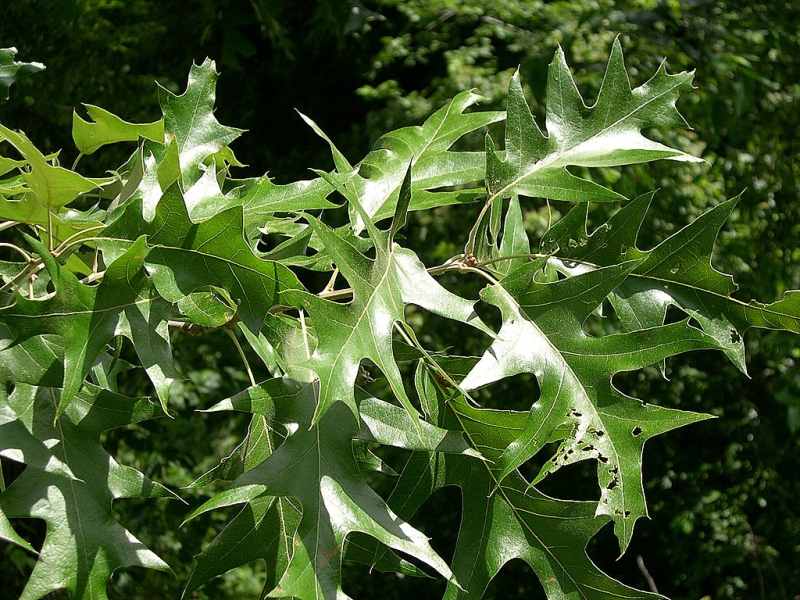
Photo Credit: Jay Sturner from USA / Wikimedia Commons / CC BY 2.0
Consider the black oak tree if you want to add a touch of natural beauty to your backyard in Virginia’s capital region. This stunning native tree boasts glossy, dark green leaves that turn brilliant shades of orange, brown, and yellow in the fall, creating a striking contrast against its black bark.
In the summer, its acorns provide food for local wildlife, such as squirrels, turkeys, white-tail deer, and other small mammals. Not only is the black oak visually appealing, but it’s also a hardy and low-maintenance tree that makes a beautiful shade for large areas. So why not bring a piece of Virginia’s natural beauty to your backyard with the majestic black oak tree?
Plant type: Tree
USDA Hardiness Zone: 3 to 9
Sun: Full sun.
Soil: Prefer deep, fertile, medium moisture, well-drained soil, but tolerates poor dry soils.
Duration: Deciduous perennial.
Fragrance: No fragrance.
Bloom time: Spring
Water needs: Dry to moderate. Well-drained soil.
Mature height: 50 to 60 feet
Potential hazards: It is toxic to horses.
Maintenance: Low. The best time to propagate this plant is mid-autumn or late winter, either through seed or grafting. Its deep taproot makes transplanting a challenging task.
2. Willow Oak (Quercus phellos)
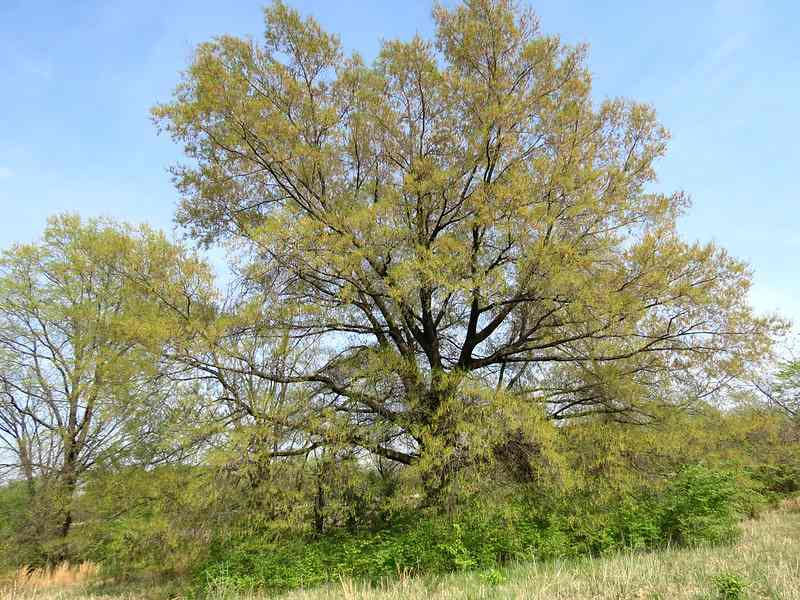
Photo Credit: Katja Schulz / Flickr / CC BY 2.0
The willow oak is a fantastic option for homeowners looking to add beauty to their backyard. This native tree is a sight to behold, with its bright green foliage during the summer months and its stunning yellow or russet hues in the fall. The tree’s bark is also a standout feature, ranging from dry to dark brown and providing a unique texture to your landscape.
Not only is the willow oak a visually striking addition, but it also provides food for several species of birds and mammals. This tree is a fast grower, which means you’ll be able to enjoy its many benefits in no time. From its natural beauty to its wildlife contributions, the willow oak is an excellent choice for backyard enthusiasts looking to enhance their outdoor space.
Plant type: Tree
USDA Hardiness Zone: 5 to 9
Sun: Full sun.
Soil: Clay, loam, sand. Acid, neutral. Moist but well-drained.
Duration: Deciduous perennial.
Fragrance: No fragrance.
Bloom time: Spring
Water needs: Moderate to High.
Mature height: 40 to 75 feet
Potential hazards: It is toxic to horses.
Maintenance: Low. The Willow oak showcases impressive resilience by enduring the destructive impact of strong winds and substantial amounts of ice and snow without succumbing to breakage. To uphold its shape, it is advisable to prune it regularly, while it’s recommended to fertilize it thrice annually.
3. Sassafras (Sassafras albidum)
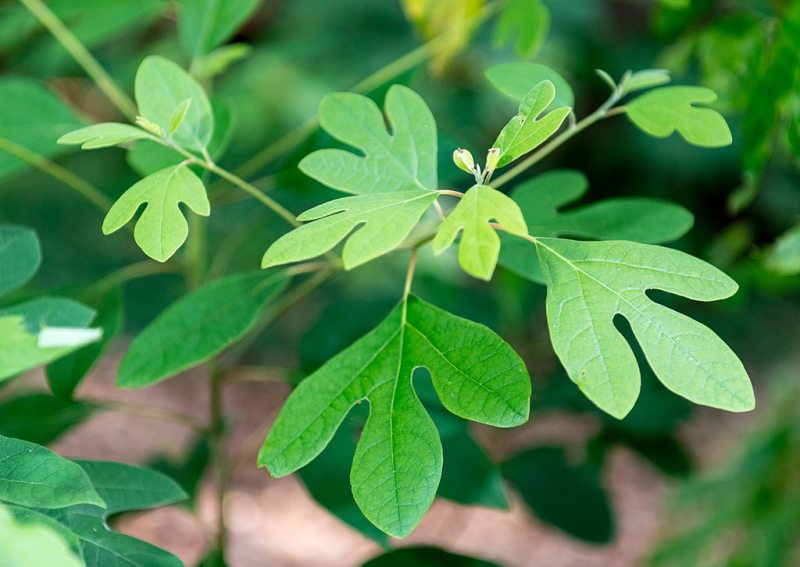
Photo Credit: Randy Everette / Wikimedia Commons / CC BY-SA 3.0
Sassafras is a versatile and beautiful tree to plant in your yard. This native tree boasts unique, mitten-shaped leaves that turn gorgeous shades of orange, red, and yellow in the fall, making it a stunning addition to any autumn landscape.
But sassafras is more than just a pretty face – it also produces fragrant, spicy bark and roots used in traditional medicine and cooking. Plus, it’s relatively low-maintenance and can live well in various soil types and sun exposures.
Plant type: Tree
USDA Hardiness Zone: 4 to 9
Sun: Full sun to partial shade.
Soil: Clay, loam, acid, neutral. Moist but well-drained.
Duration: Deciduous perennial.
Fragrance: Aromatic properties are present in all parts of the common sassafras tree. When the young bark is scratched, it emits a delightfully spicy fragrance.
Bloom time: Spring
Water needs: Low to moderate.
Mature height: 30 to 60 feet
Potential hazards: This plant has low-severity poison characteristics.
Maintenance: Average. To maintain a shrub-like size, sassafras trees can be pruned by cutting them down to the ground every 2 to 3 years. Additionally, it’s important to protect this tree from harsh winter conditions.
4. Common Partridge Pea (Chamaecrista fasciculata)
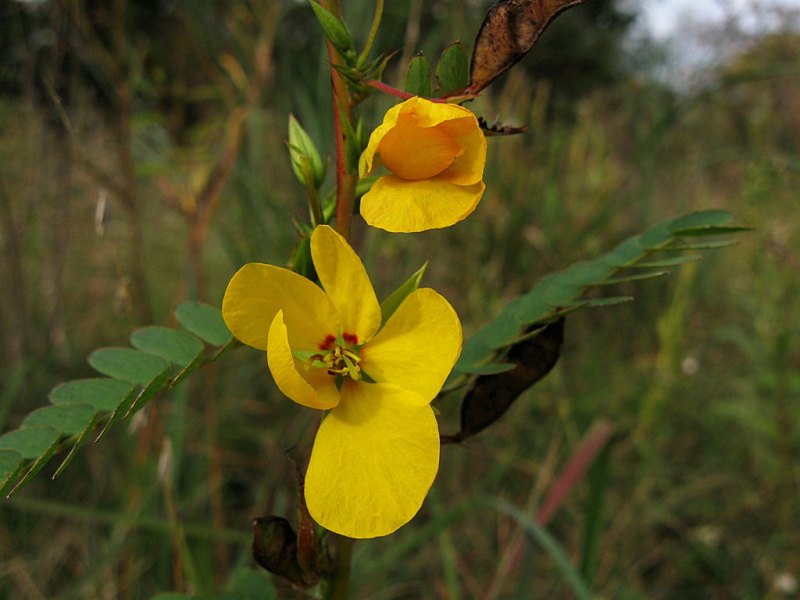
Photo Credit: Cbaile19 / Wikimedia Commons / CC0
If you dream of adding some vibrant color and texture to your backyard, the common partridge pea is a native plant that you won’t want to overlook. This striking wildflower produces clusters of showy yellow blooms throughout the summer, attracting pollinators like bees and butterflies to your yard.
Its deep roots can help improve soil health and prevent erosion, making it an excellent choice for areas with poor soil or sloping terrain. And with its ability to tolerate drought and flooding, the common partridge pea is a hardy and adaptable addition to any garden.
Plant type: Herbaceous
USDA Hardiness Zone: 3 to 9
Sun: Full sun.
Soil: Clay, loam, sand. Acid, alkaline, neutral. Well-drained.
Duration: Deciduous annual.
Fragrance: No fragrance.
Bloom time: Summer
Water needs: Dry to moderate.
Mature height: 1 to 3 feet
Maintenance: Low. This plant has an aggressive self-seeding habit, especially in dry and open spaces. For optimal growth, it’s recommended to sow the seeds between late March and May.
5. Smooth Oxeye (Heliopsis helianthoides)
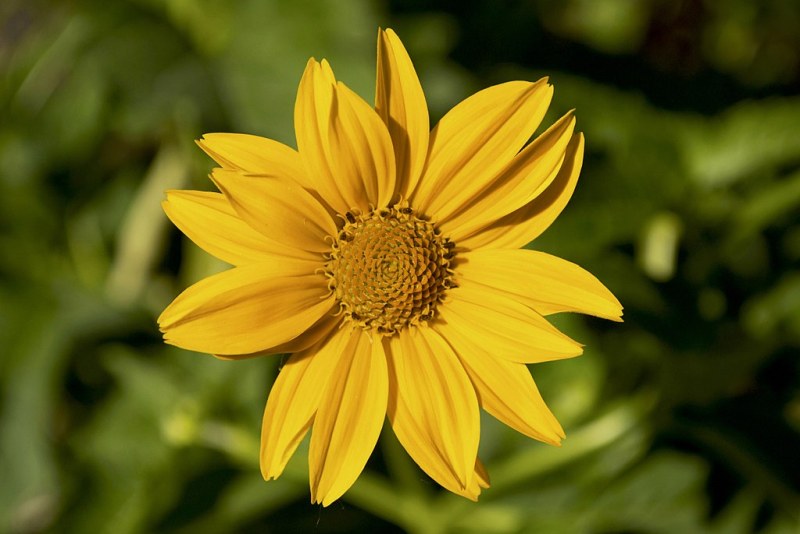
Photo Credit: Lystopad / Wikimedia Commons / CC BY-SA 4.0
The smooth oxeye is a gorgeous wildflower that requires little maintenance. Its bright yellow blossoms and unique serrated leaves are eye-catching and can add color to any sunny area of your yard. This plant is hardy and simple to cultivate, making it a great option for any gardener. Plus, its attractive blooms are known to attract bees, butterflies, and even hummingbirds, adding to the liveliness and beauty of your backyard.
Plant type: Herbaceous
USDA Hardiness Zone: 3 to 9
Sun: Full sun to partial shade.
Soil: Chalk, clay, loam, sand. Acid, alkaline, neutral. Moist but well-drained.
Duration: Deciduous perennial.
Fragrance: No fragrance
Bloom time: Autumn, spring, and summer.
Water needs: Moderate.
Mature height: 3 to 6 feet
Maintenance: Low. To encourage prolonged blooming, it’s recommended to deadhead the flowers. After the flowering period, cutting the plant back is also advised.
6. Arrow Arum (Peltandra virginica)
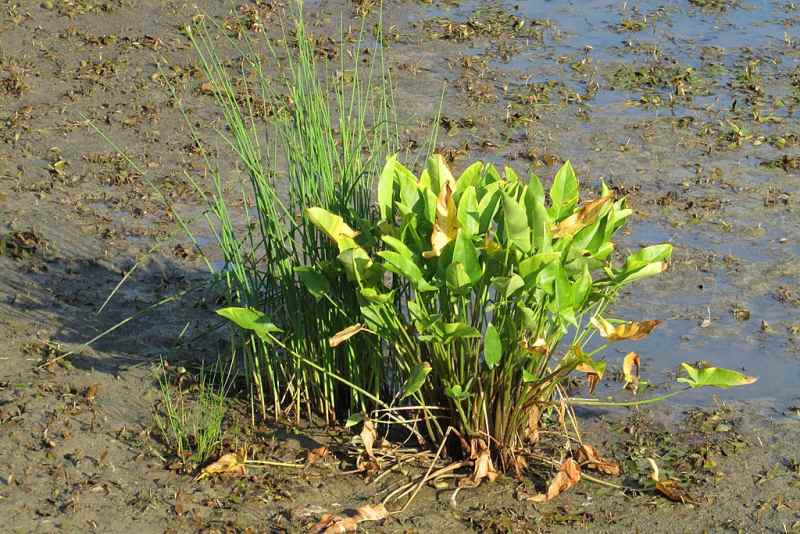
Photo Credit: Chris Light / Wikimedia Commons / CC BY-SA 4.0
For those seeking a captivating and hardy plant to enhance their Virginia backyard, the arrow arum is an aquatic plant sure to make a splash. With its glossy, dark green leaves and long stalks, this native species can add a touch of elegance to any water feature or garden.
The large leaves are striking and can vary in shape and size, but often they feature an arrowhead shape. Arrow arum is a vigorous grower; once established, it can spread to fill out any space. The arrow arum is a choice that will delight you and any visitors to your yard.
Plant type: Aquatic herbaceous
USDA Hardiness Zone: 5 to 9
Sun: Full sun to partial shade.
Soil: Clay, loam, sand. Acid, alkaline, neutral. Poorly drained.
Duration: Perennial
Fragrance: No fragrance.
Bloom time: Spring and summer.
Water needs: Wet
Mature height: 1.5 to 2 feet
Maintenance: Moderate. Arrow arum is a versatile plant that can thrive in standing water up to 6 inches deep or consistently moist, boggy soils. This plant can be propagated through either seed or division.
7. Wild Pink (Silene caroliniana)
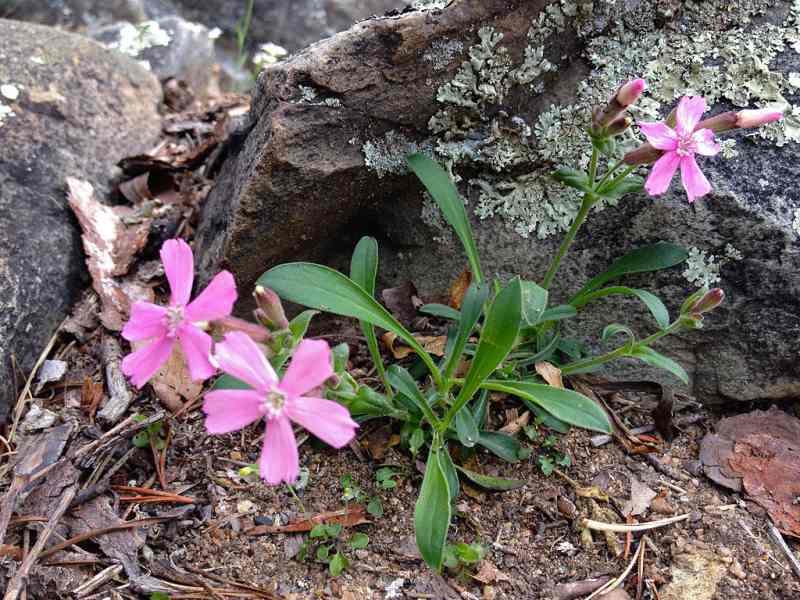
Photo Credit: Fritzflohrreynolds / Wikimedia Commons / CC BY-SA 3.0
For those looking for a plant that is both showy and easy to care for in their backyard, the wild pink is an excellent option to consider. This plant will embellish any outdoor space with its rosy pink flowers resembling phlox and forming five wedge-shaped petals in a tubular shape.
Wild pink is a compact, mat-forming plant that gives a splash of color to any landscape. Its hardy nature makes it a fantastic choice for those looking for a low-maintenance plant. The plant produces a fruit capsule that splits open to release tiny brown seeds, which can easily propagate and establish new plants.
Plant type: Herbaceous
USDA Hardiness Zone: 5 to 8
Sun: Full sun.
Soil: Chalk, loam, sand. Alkaline, neutral. Well-drained.
Duration: Perennial.
Fragrance: No fragrance.
Bloom time: Spring.
Water needs: Low.
Mature height: 10 inches to 1 foot
Maintenance: Low. Once the plant is established, it prefers not to be disturbed. However, it can be propagated through various methods, such as seeds, cuttings, or division.
8. Red Chokeberry (Aronia arbutifolia)
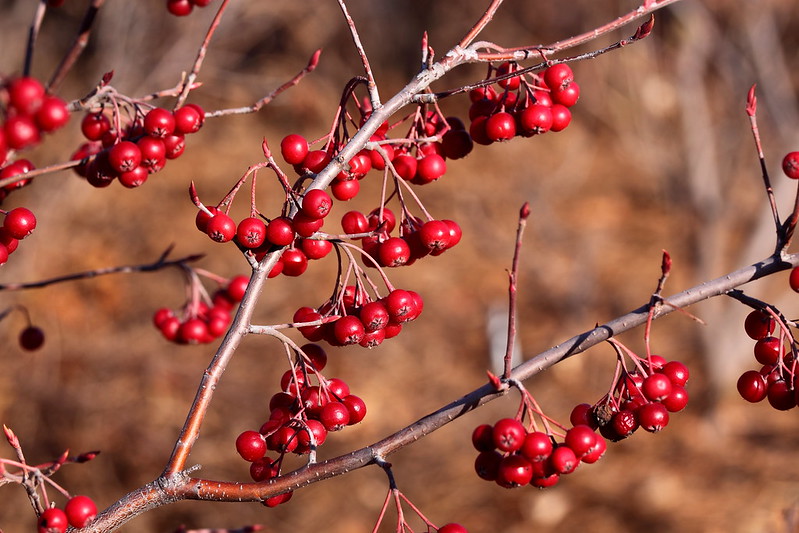
Photo Credit: Mr.TinMD / Flickr / CC BY-ND 2.0
For a multi-seasonal showstopper in your Virginia backyard, the red chokeberry is an excellent choice. This multi-stemmed shrub offers something unique in every season.
In the spring, the red chokeberry showcases flat-topped clusters of white to light pink, five-petaled flowers with red anthers that bloom in abundance. The dark green, glossy leaves emerge following the flowers, providing a lush backdrop that consistently transforms into a stunning orange-red hue in the fall. The plant produces bright red, pear-shaped berries that stay on the shrub until December or January, adding a pop of color to the winter landscape.
The reddish-brown, exfoliating bark provides additional visual interest during the colder months. With its year-round appeal, the red chokeberry is an ideal choice for any Virginia backyard looking to add natural beauty and color..
Plant type: Shrub
USDA Hardiness Zone: 4 to 9
Sun: Full sun to partial shade.
Soil: Clay, loam. Acid, neutral. Moist but well-drained.
Duration: Deciduous perennial
Fragrance: Flowers have a sweet scent.
Bloom time: Flowers blossom in spring. But it has a four-season interest.
Water needs: Medium
Mature height: 5 to 10 feet
Maintenance: Low. These plants can endure wet sites and even occasional flooding. They can be propagated through various methods, such as seeds, soft-wood cuttings, or taking out suckers and potting them during the plant’s dormant period.
How to Choose Native Plants for Your Virginia Capital Region Yard
Planting native plants in your backyard can provide many benefits, such as supporting local ecosystems, attracting wildlife, and reducing the need for fertilizers and pesticides. However, not all native plants are good for every backyard. When selecting the right plant, factors such as soil type, sunlight, and moisture levels must be considered.
Additionally, it is essential to be aware of your backyard’s hardiness zone, which determines your area’s climate conditions and temperature range. Virginia’s capital region USDA hardiness zone is 6 and 7, which means plants suitable for those zones can tolerate the region’s typical winter temperatures.
FAQ About Native Plants in Virginia’s Capital Region
What are other common native plants of Virginia’s capital region?
Here’s a plant list of some popular native plant species for the Virginia department:
- Virginian Witch Hazel
- American Elder
- Mountain Laurel
- Common Milkweed
- Eastern Red Cedar
- Cornus Amomum
- Smooth Blue Aster
- Wild Columbine
For more information on native wildflowers, groundcovers, trees, invasive species, and shrubs, visit the PlantVirginiaNatives.org website.
What plants are native to Richmond?
Richmond has many native plants, including:
- Virginia Bluebells
- Red Columbine
- American Witchhazel
- Sweetbay Magnolia
- Swamp Azalea
- Butterfly Weed
- Mountain Laurel
- Flowering Dogwood
- Wild Hydrangea
- Coral Honeysuckle
When should I water my native plants?
To thrive native plants thrive in soil that is deeply moistened and not frequently watered. It is recommended to provide a single 30-minute soak every 7-10 days instead of multiple 10-minute waterings per week. The frequency of watering should be determined based on several factors, such as the soil type, exposure to sunlight, weather conditions, and the age of the plant.
What are the best plants for Southeast Virginia?
Southeast Virginia’s native plants include:
- Red chokeberry
- Common buttonbush
- American beautyberry
- American witch hazel
- Common winterberry
- Eastern redbud
- Flowering dogwood
- Black huckleberry
- Butterfly milkweed
- Beebalm
What are the best plants for Northern Virginia?
Northern Virginia’s native plants include:
- Red columbine
- Common yarrow
- Yellow wild indigo
- White turtlehead
- Maryland golden-aster
- Spring beauty
- Eastern rose-mallow
- Turk’s-cap lily
Where to Find Native Plants in Virginia’s Capital Region
It is highly recommended to purchase native plants from local nurseries. They offer a wide selection of plant species that are well-suited to the local climate and soil conditions and employ knowledgeable staff who can give expert advice on native plant care and maintenance.
For additional information on sustainability initiatives, guides on native plants, and the significance of native plants, kindly visit the website of the Virginia Native Plant Society.
When beginning your landscaping dream, it’s important to remember that choosing the appropriate plant is just the initial step. Sustaining the well-being of your lawn is just as crucial in ensuring the long-term prosperity of your landscape.
Looking for a Virginia lawn care pro near you to maintain your landscape? We have trusted pros in Richmond, Chesterfield, and various other cities throughout Virginia’s Capital Region.
Main Photo Credit: Maymont Park / Watts / Flickr / CC BY 2.0